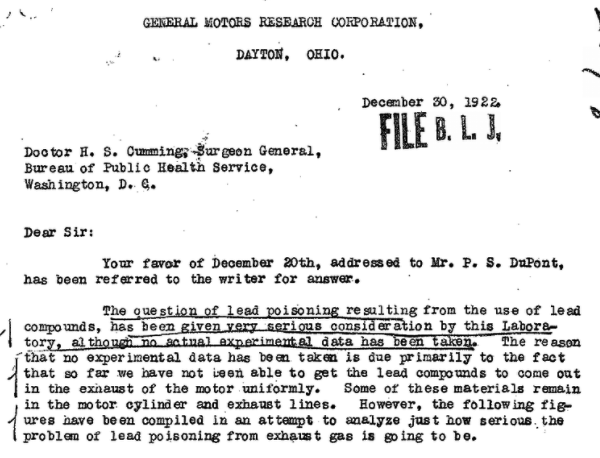Using ToxicDocs in the Classroom: The Tetraethyl Lead Controversy, Part III
Today, we're continuing our series of blog posts highlighting student investigations into tetraethyl lead using ToxicDocs primary sources. Tetraethyl lead was added to gasoline beginning in the 1920s through the 1960s despite the serious concerns of public health officials. Check out the first post in the series here and the second here. We will continue posting student research over the coming days, piecing together a more complete picture of the TEL controversy and demonstrating how ToxicDocs can be used in the classroom.
Two students looked into a key player in the tetraethyl lead controversy, Thomas Midgley. First up is Tanya Bhalla, an economics and history major at Barnard College.
Last week, a document I found fascinating was this letter dated 1922, from an engineer in the General Motors lab affirming that lead poisoning was not a true risk because it was found in such small amounts, even though "no actual experimental data has been taken." The questions I had were pertaining the individuals involved in this letter. I wanted to see if I could find out more about Thomas Midgley, chief engineer in the fuel section at General Motors Research Corporation.
It turns out that Thomas Midgley Jr. was a key figure in the team of chemists that actually developed tetraethyl lead (TEL) additive to gasoline as well as some of the first chlorofluorocarbons (CFCs.) Midgley had joined GM in 1916 and he actually discovered that adding TEL to gasoline would prevent knocking in internal combustion engines. GM strategically named the substance "ethyl" to avoid any mention of lead. GM filed a patent for TEL with Midgley and Kettering and together they promoted it as an superior alternative to ethanol or ethanol blended fuels. Midgley was given many awards and distinctions over his career for his work, but ironically he had to take a long break one year after this letter was addressed because he had contracted lead poisoning himself.
Miranda Diaz, an urban studies major at Barnard College, began her investigation into Midgley using same letter as Bhalla, from Midgley to Dr. H.S. Cumming.
The document I explored is a letter from Thomas Midgley, the chief engineer from General Motors Research Corporation to the Bureau of Public Health Service Doctor H.S. Cumming in 1922. Engineer Midgley conveyed great certainty that risk of lead poisoning in the busy and congested transportation tunnel under the Hudson River was low, even with no experimental data.
To better understand this letter, who are Thomas Midgley and Doctor H.S. Cumming? During 1922, what did the public know about the risk of lead and the risk of using leaded gasoline? Also, how did the public perceive General Motors and the Public Health Service? Did the Public Health Service play an active role in educating the people about health risks such as lead? I am most interested in the knowledge of the public because many of the documents appear to be private letters between companies and I am curious to know how much and what information was provided to the public. I am also curious if there had been any documented illnesses related to the Hudson tunnel.
While searching "Thomas Midgley" in ToxicDocs, I found this Q&A document from 1965 which does not provide explicit information about the two parties questioning and answering, but I infer the party providing answers is from the Ethyl Corporation, a company that manufactured tetraethyl lead (an antiknock compound). Thomas Midgley is mentioned in a question asking whether the "originators" of tetraethyl lead died from lead poisoning. The response states that Dr. Midgley had not died from lead poisoning, but from polio in the 1940s. The document also continues to support Midgley's claims that there is little to no risk in lead. When asked about the risk of tetraethyl lead in gas, the responder states, "the lead alkyl portion of antiknock compounds, as ordinarily found in gasoline at service stations, presents no health hazard to the public" and, "the only danger would be from the gasoline itself." Forty years later, companies continued to assert their claim and position of the low risk of tetraethyl lead in gasoline.
We will be posting more student findings on tetraethyl lead over the next few weeks!

